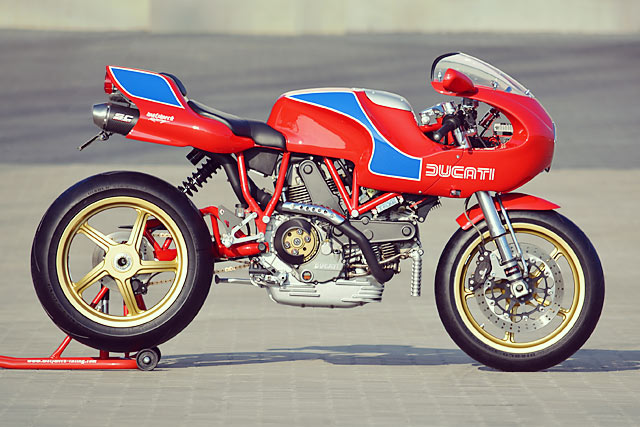
.
It was the result of three great forces combining to build a beloved motorcycle that tugged at the heart-strings of the Ducatisti around the globe. The legendary feats of Mike “the Bike” Hailwood, the brilliance of head Ducati designer Pierre Terblanche and the global power of a relatively new communications tool for the masses, the internet. The result was the limited run Ducati MH900e of which only 2000 were built over a period of two years. Special edition Ducati’s have always held their value and leaving them standard is just what you’re meant to do. But Roland Sands got Italian blood boiling when he chopped up a Desmosedici and created a 200hp tracker. Now it’s Germany’s superstar builder Marcus Walz’s turn to improve on perfection, it’s the WalzWerk Racing MH900e.
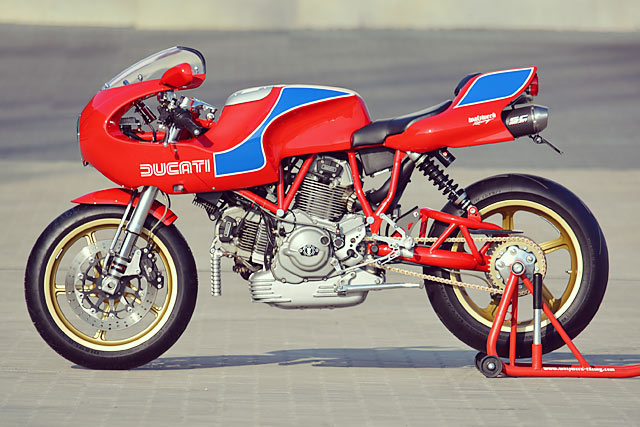
When Ducati showed up to the 1998 Intermot Show in Munich with just a sketch of the bike the crowds went crazy. Terblanche had penned his homage to Hailwood’s win for Ducati at the Isle of Man TT in 1978. With such a response, Ducati decided to run an online poll to determine if they should put the bike into production. Just three hundred people responded, but in those days that was considered enough of an online craze to turn the sketch into a special production bike and Bimota were given the job of bringing it to life. Unfortunately, the little Italian company went bust and so in a corner of the Bologna factory, Ducati mechanics built 4 or 5 a day. Here sits 586 of 2000.
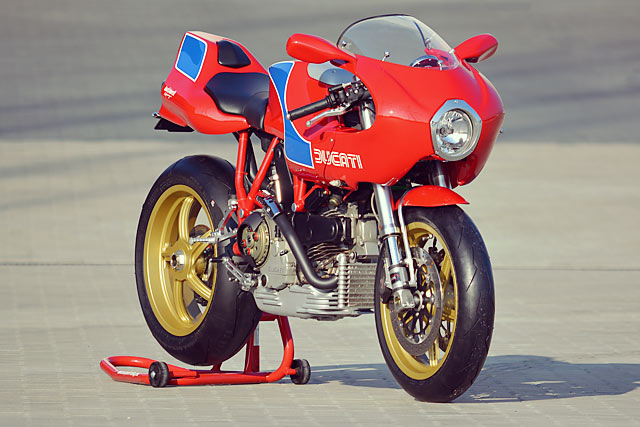
The MH900e racer was also the first bike sold exclusively online and when the clock struck 00:01am GMT January 1, 2000 at a price of €15,000 the first run of a thousand bikes sold in just 31 minutes. A quarter of a century later an MH900e fetches more than its original asking price, but rather than sell the low mile machine, Marcus had in his living room he decided it was time to roll it into the workshop. Firstly because building custom bike is what he does better than almost anyone on the planet. Secondly because while he was a huge fan of the Terblanche styling, the sketch-turned-real-motorcycle was always a compromise and that was something Walz wanted to end.
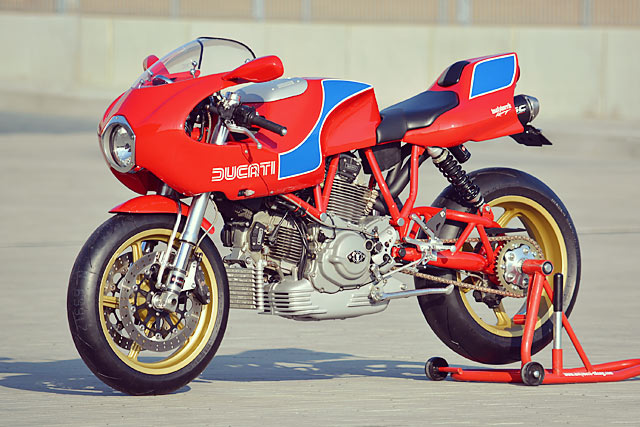
The engine was first to get the German’s special treatment and although it only had 3,000 miles on the clock, it was time for a full rebuild. Based on a 900ss engine the original pushed out a fairly asthmatic 55kw. With the engine apart the SOHC heads have been heavily flowed and now benefit from the extra numbers of a Ducati performance cam. “We swapped the stock cam cover for a set of vintage cam covers from a Ducati Pantah 650 to give the engine that extra classic look,” says Marcus.
A custom airbox with K&N air filter makes sure the 904cc donk has plenty of air to feed the new heads. Getting the gases out of the engines sees another of Walz’s brilliant collaborations with exhaust powerhouse SC-Project.
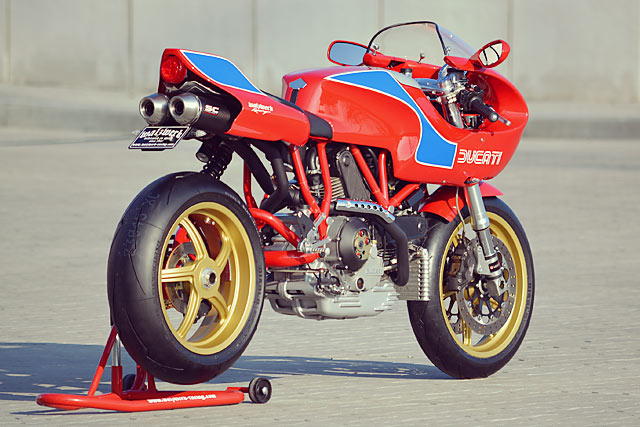
The short length system hugging the engine tight before exiting under the tail thanks to two big dollar carbon fibre cans. Allowing the engine to spin more freely is a superlight flywheel with the gearbox a lower ratio Monster 900 set. While a slipper clutch from a 996RS and a hydraulic clutch unit from DucaBike bring cog swapping into the 21st century.
The secondary chain drive was swapped to a 520 racing chain setup with an aluminium racing front wheel and a SuperSport racing sprocket. “A Dyno Power Commander was added to tune the engine to almost 100hp on the rear wheel,” says Marcus. And finally, the MH had the kind of ponies Mike the Bike would have wanted.
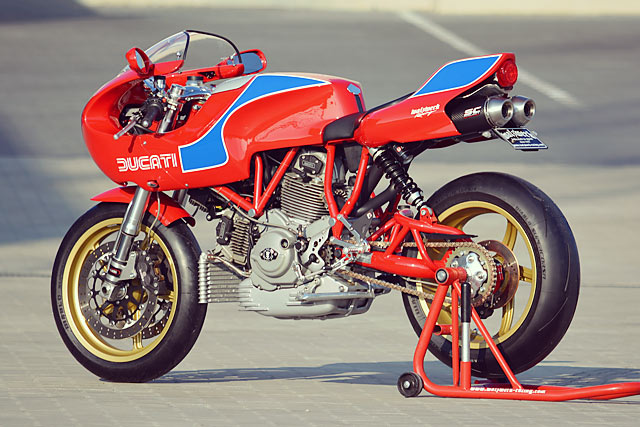
With a stonking engine sitting on the bench many would turned to the suspension next but Walz, being a racer, wanted to know the final weight first. So he shifted his focus to ridding the Ducati of any extra baggage and giving the bike an updated look. “The bike comes stock with two big batteries, mounted underneath the steering neck. That whole installation weighs around 12kg with brackets and batteries,” he exclaims. A new superlight lithium battery was picked up with a small casing fabricated that saved weight and created increased space for the new airbox.
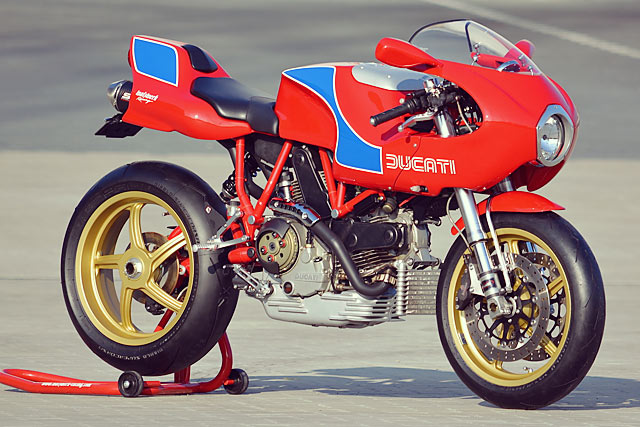
The frame, although better than something fitted to a stock unit, still copped the wrath of the grinder. Extra brackets were removed, welds were tidied up and any and all extra weight removed until it was of Walz’s satisfaction. Further aiding in the weight cut, the clutch is now all but exposed with a small dry carbon cover. The Desmo engines belts are now encased in carbon and even the heel guards have been swapped out for the lightweight material.
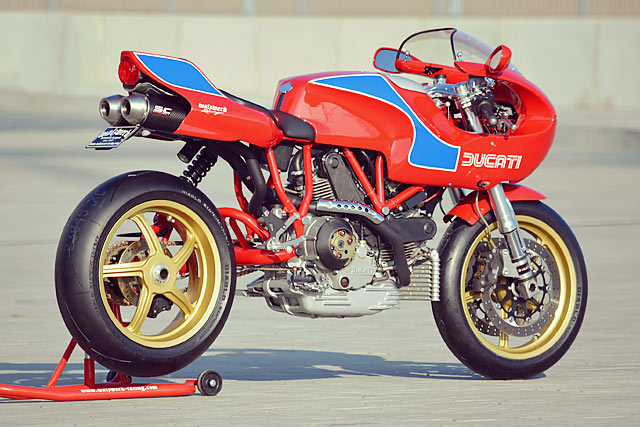
But when it came to that bodywork, Terblanche’s futuristic take on the ’78 TT machine that took Hailwood to victory in his famous comeback to the Formula one race, Marcus couldn’t bring himself to change it. “We kept the stock bodywork, because there is nothing which I would have changed as it just looks perfect. I just designed a new paint scheme to make it look more vintage. So the colour red and blue are from the Ducati TT’s from the 70’s which in my opinion match perfectly the lines of the bike.”
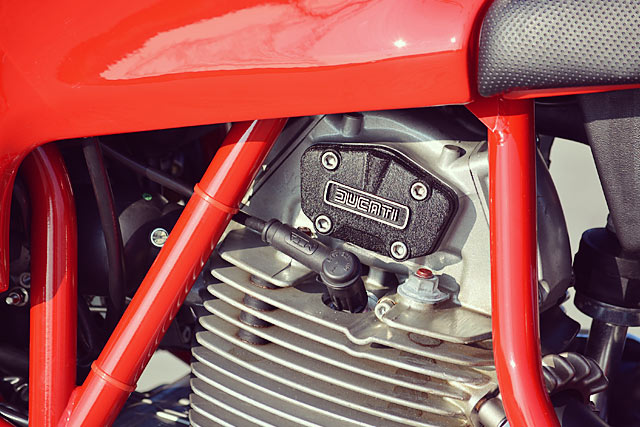
Now with a good idea on the weight and power he was dealing with, 50% more ponies and 20kg less lard, the work on the braking and suspension could be set up with a focus on quick track riding. Wilbers built a prototype fully adjustable rear shock for that gorgeous tubular single-sided swingarm.
While up front Wilbers came to the party again; the USD 43mm forks are now totally rebuilt with new progressive rate springs and fork oil to match. While showing the bike’s true intention, a steering damper is now tucked under the lip of the tank, preventing any nasty tank slappers.
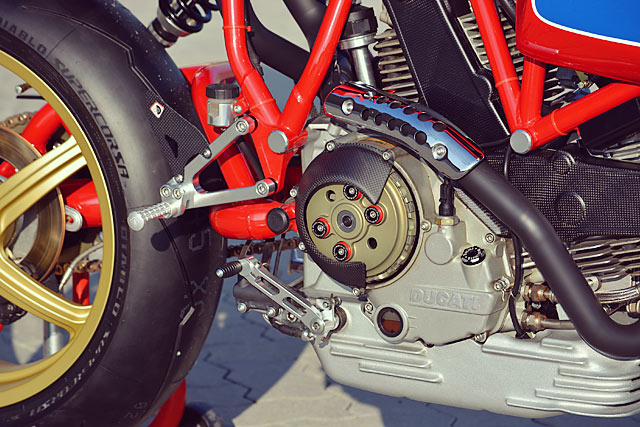
As you would expect, braking is all Brembo with 320mm twin discs at the front now treated to the latest pad technology from the big Italian. The stunning, lightweight 5 spoke wheels have been coated in a race rim gold to give the red paint a little extra pop. While the rubber is as sticky as you’d want to ride on the road, with Pirelli Diablo Supercorsa’s front and rear. With more track-focused parts coming in the form of machined, raised rearsets from DucaBike and LSL adjustable brake and clutch levers to give a fully tailored riding position.
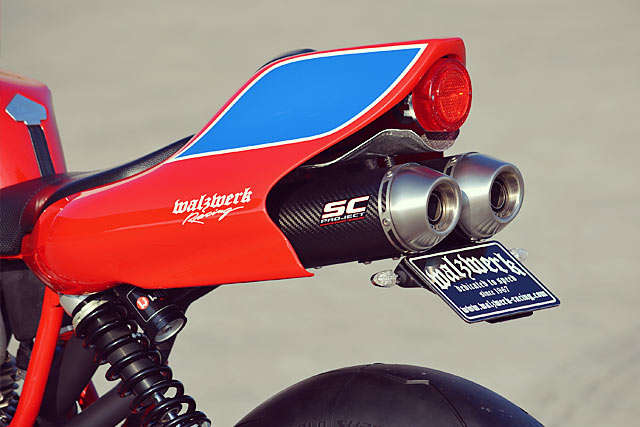
To finish out the build, Marcus simply complemented many of the amazing factory parts with those from his own catalogue. The filler cap, the incredible triple trees and that classic analogue tacho were all fitted from the factory and exclusively made for the MH900e. And adding some German flavour are WalzWerk’s black-machined alloy timing inspection and clutch cable covers and a machined oil filler.
A tail-tidy and small LED indicators rid the bike of the last factory components that attempted to ruin the Ducati’s special lines and the finished product is simply an automotive work of art.
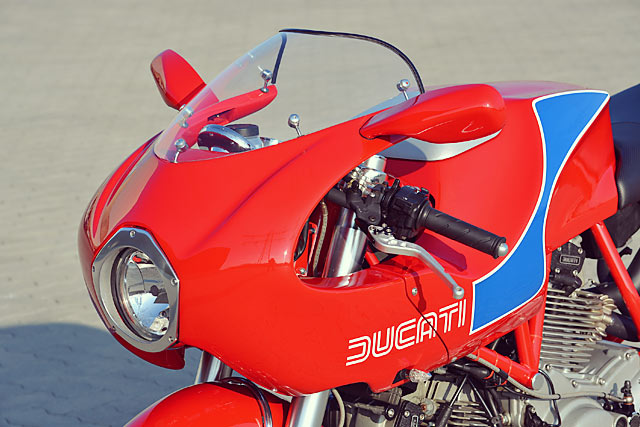
While many factory specials share almost all their DNA with a stocker, the MH900e used 80% unique parts. That it sold at the time for a “reasonable” price is not a luxury we have today, with some exotic machines from Ducati and Honda exceeding 100k. So it’s no surprise then that as soon as the Walz MH900e was finished, someone snapped it up quick smart, the downside of building amazing machines. “Unfortunately, when I put it in my showroom after it was finished, along came a lucky guy with a wad of cash. When he made me an offer, I just couldn’t say no.” But before it had journeyed to its new home, Marcus did enjoy some laps on the track at Oschersleben, no doubt with “Mike the Bike” calling down from the sky. “Give it the beans, old boy.”

